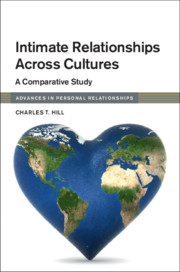Book contents
- Intimate Relationships Across Cultures
- Advances in Personal Relationships
- Intimate Relationships Across Cultures
- Copyright page
- Epigraph
- Contents
- Figures
- Tables
- Spotlights
- Collaborators
- Foreword
- Acknowledgments
- Introduction: Why Was This Book Written?
- 1 How Do We Know What Matters in Intimate Relationships?
- 2 Why Do People Seek Intimate Relationships?
- 3 How Are Intimate Partners Selected?
- 4 What Is Love and How Is Intimacy Expressed?
- 5 How Do Sexual Attitudes and Behaviors Matter?
- 6 What Are the Dynamics of Exchange and Power?
- 7 How Do Couples Cope with Conflict?
- 8 How Do External Factors Matter in Intimate Relationships?
- 9 How Do Intimate Relationships Relate to Well-Being?
- 10 How Do the Predictions Combine in Comprehensive Models?
- 11 How Much Do the Levels of Factors Vary?
- 12 What Are the Implications of the Study?
- 13 How Might the Findings Apply to Other Social Relationships?
- Epilogue: What Future Research Is Needed?
- Glossary of Statistical Terms
- Boston Couples Study Publications
- References
- Index
4 - What Is Love and How Is Intimacy Expressed?
Published online by Cambridge University Press: 21 June 2019
- Intimate Relationships Across Cultures
- Advances in Personal Relationships
- Intimate Relationships Across Cultures
- Copyright page
- Epigraph
- Contents
- Figures
- Tables
- Spotlights
- Collaborators
- Foreword
- Acknowledgments
- Introduction: Why Was This Book Written?
- 1 How Do We Know What Matters in Intimate Relationships?
- 2 Why Do People Seek Intimate Relationships?
- 3 How Are Intimate Partners Selected?
- 4 What Is Love and How Is Intimacy Expressed?
- 5 How Do Sexual Attitudes and Behaviors Matter?
- 6 What Are the Dynamics of Exchange and Power?
- 7 How Do Couples Cope with Conflict?
- 8 How Do External Factors Matter in Intimate Relationships?
- 9 How Do Intimate Relationships Relate to Well-Being?
- 10 How Do the Predictions Combine in Comprehensive Models?
- 11 How Much Do the Levels of Factors Vary?
- 12 What Are the Implications of the Study?
- 13 How Might the Findings Apply to Other Social Relationships?
- Epilogue: What Future Research Is Needed?
- Glossary of Statistical Terms
- Boston Couples Study Publications
- References
- Index
Summary
William James and Carl Lange proposed in the 1880s that every emotion has a unique pattern of physiological responses (Cannon, 1927), but when researchers studied emotional responses, they found overlapping responses, such as increased heart rate for anger, fear, and surprise. So Schachter and Singer (1962) proposed that all emotions have the same physiological arousal, and what differentiates them is labeling based on cognitive cues. For example, my heart is racing and I look around and see that I am in a street and a car is approaching me; therefore, I must be afraid.
But while physiological responses often overlap among emotions, they are not always the same. For example, blood rushes to the face when angry but away from the face when frightened, and heart rate slows when sad. And in most cases, the cue comes before the arousal and indeed causes the arousal, e.g., my heart is racing because I saw the approaching car. Hence, researchers thought it was impossible to measure emotions, including love.
- Type
- Chapter
- Information
- Intimate Relationships across CulturesA Comparative Study, pp. 73 - 83Publisher: Cambridge University PressPrint publication year: 2019



